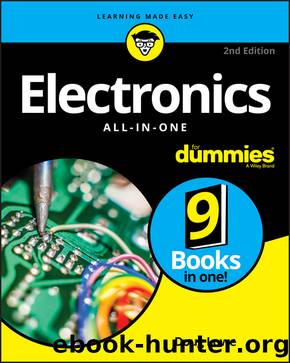Electronics All-In-One for Dummies by Lowe Doug;

Author:Lowe, Doug; [Lowe, Doug]
Language: eng
Format: epub
Publisher: John Wiley & Sons, Incorporated
Published: 2017-01-25T00:00:00+00:00
Using Line Voltage in Your Projects
So far, none of the projects presented in this book have involved the use of line voltage. But many — if not most — real-world projects do require that you use line voltage.
The most common reason for using line voltage in a project is to eliminate the need for batteries. Batteries are a convenient source of power for your circuits, but they wear out. For many circuits, you want to provide a power source that will last indefinitely. If you use batteries, they’ll eventually lose their charge and have to be replaced. If you use line voltage, you can plug the project in and not have to worry about changing batteries.
Of course, most electronic components require direct current rather than alternating current, and at much lower voltage levels than the levels that line voltage supplies. Thus, for your project to use line voltage as its source of power, you need to provide the project with a power supply that converts the 120 VAC line voltage to something more useful, such as 5 VDC.
There are at least two ways to accomplish this:
By using a power adapter: The easiest way is to use an external power adapter, often called a wall wart or a power brick. Figure 1-4 shows a typical external power adapter. You can purchase power adapters from just about any store that has a consumer electronics department. Just get one that provides the right level of DC voltage and use it instead of batteries.
By building your own power supply: The alternative to purchasing a power adapter is to build your own power supply circuit. This circuit must accomplish two things. First, it must step the voltage down from 120 VAC to whatever voltage your circuit requires, and second, it must convert the AC voltage to DC voltage. You learn how to design and build a power supply circuit in the next chapter.
Download
This site does not store any files on its server. We only index and link to content provided by other sites. Please contact the content providers to delete copyright contents if any and email us, we'll remove relevant links or contents immediately.
| Circuits | Digital Design |
| Electric Machinery & Motors | Electronics |
| Fiber Optics | Networks |
| Superconductivity |
Whiskies Galore by Ian Buxton(40297)
Introduction to Aircraft Design (Cambridge Aerospace Series) by John P. Fielding(32331)
Small Unmanned Fixed-wing Aircraft Design by Andrew J. Keane Andras Sobester James P. Scanlan & András Sóbester & James P. Scanlan(32135)
Craft Beer for the Homebrewer by Michael Agnew(17439)
Turbulence by E. J. Noyes(7032)
The Complete Stick Figure Physics Tutorials by Allen Sarah(6631)
Kaplan MCAT General Chemistry Review by Kaplan(6044)
The Thirst by Nesbo Jo(5778)
Bad Blood by John Carreyrou(5761)
Learning SQL by Alan Beaulieu(5399)
Weapons of Math Destruction by Cathy O'Neil(5029)
Man-made Catastrophes and Risk Information Concealment by Dmitry Chernov & Didier Sornette(4728)
iGen by Jean M. Twenge(4693)
Digital Minimalism by Cal Newport;(4511)
Life 3.0: Being Human in the Age of Artificial Intelligence by Tegmark Max(4492)
Audition by Ryu Murakami(4091)
1,001 ASVAB Practice Questions For Dummies by Powers Rod(4034)
Electronic Devices & Circuits by Jacob Millman & Christos C. Halkias(4021)
Pale Blue Dot by Carl Sagan(3996)
